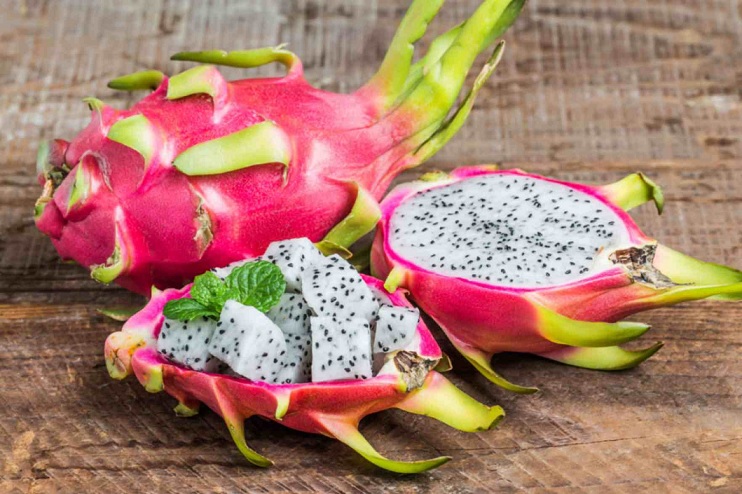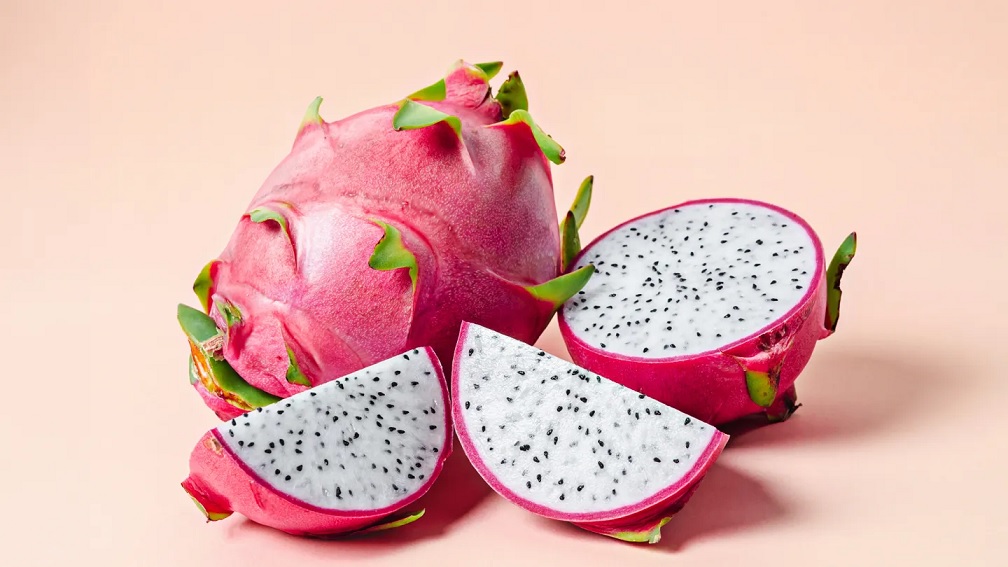Dragon fruit, also known as pitaya or pitahaya, is one of the most eye-catching fruits you’ll ever see. With its bright pink or yellow skin and spiky green scales, dragon fruit looks like something out of a fantasy story. But don’t be fooled—this fruit is very real and packed with nutrients. It not only tastes great but also offers several health benefits. In this article, we’ll explore everything you need to know about dragon fruit, from its origin and types to its health benefits, how to eat it, and more.
Table of Contents
What is Dragon Fruit?
Dragon fruit is the fruit of a type of cactus. It grows in warm, tropical areas like Central America, South America, Southeast Asia, and parts of the United States such as Florida and California. The fruit has a sweet, refreshing taste and is usually eaten raw.
Other Names for Dragon Fruit
- Pitaya
- Pitahaya
- Strawberry pear
Types of Dragon Fruit
There are three main types of dragon fruit. The difference comes mostly from the color of the skin and the inside flesh.
White-Fleshed Dragon Fruit
- Skin: Bright pink
- Flesh: White
- Seeds: Black
- Taste: Mild and sweet
This is the most common type of dragon fruit found in stores.
Red-Fleshed Dragon Fruit
- Skin: Bright pink or red
- Flesh: Red or deep pink
- Seeds: Black
- Taste: Sweeter than the white type
This type is often used in smoothies because of its beautiful color.
Yellow Dragon Fruit
- Skin: Yellow
- Flesh: White
- Seeds: Black
- Taste: Very sweet and juicy
This is less common but is known to be the sweetest of all types.
Where Does Dragon Fruit Come From?
Dragon fruit comes from a cactus species called Hylocereus. It is believed to have started in Central America and Mexico. Today, it’s grown in many tropical and subtropical parts of the world including:
- Vietnam
- Thailand
- Malaysia
- Israel
- Australia
- United States (especially in California and Florida)
What Does Dragon Fruit Taste Like?

Many people describe dragon fruit as a mix between a kiwi and a pear. It has a light, sweet taste with a soft and slightly crunchy texture, thanks to the small black seeds inside. The red-fleshed and yellow types are often sweeter than the white-fleshed ones.
Health Benefits of Dragon Fruit
Dragon fruit is not only beautiful and tasty—it’s also very good for your health. It’s low in calories but high in vitamins, minerals, and antioxidants.
Rich in Antioxidants
Dragon fruit contains antioxidants like vitamin C, betalains, and carotenoids. These help fight free radicals in the body, which can damage cells and cause aging or illness.
Boosts Immune System
Because it’s high in vitamin C, dragon fruit helps your body fight off colds and infections. It also contains iron, which helps move oxygen around your body.
Good for Digestion
Dragon fruit is high in fiber, which is great for your digestive system. Fiber helps keep your stomach healthy and prevents constipation.
Supports Heart Health
The tiny seeds inside dragon fruit are full of healthy fats and omega-3s, which are good for your heart. Eating dragon fruit regularly may help lower bad cholesterol and improve good cholesterol.
Helps Control Blood Sugar
Some studies suggest that dragon fruit may help control blood sugar levels, making it a good snack for people with type 2 diabetes. But always ask your doctor first.
Keeps Skin and Hair Healthy
The vitamins and water content in dragon fruit can help keep your skin glowing and your hair strong. Many people even use it in homemade face masks!
Nutrition Facts (Per 100g of Dragon Fruit)
- Calories: ~50–60
- Protein: 1.2g
- Fat: 0.4g
- Carbohydrates: 13g
- Fiber: 3g
- Vitamin C: 3mg
- Iron: 1.9mg
- Magnesium: 18mg
How to Eat Dragon Fruit
Eating dragon fruit is easy, and you don’t need any special tools.
Step-by-Step Guide:
- Cut the fruit in half using a sharp knife.
- Scoop out the flesh with a spoon or cut it into cubes.
- Enjoy it raw or add it to other foods like smoothies, fruit bowls, or salads.
You can also freeze the fruit and use it later in drinks or desserts.
Fun Ways to Eat Dragon Fruit
- In smoothies with banana and mango
- As part of a fruit salad
- With yogurt and honey
- On oatmeal or cereal
- In a tropical salsa with pineapple and lime
- As frozen cubes in water for a colorful drink
How to Choose a Ripe Dragon Fruit
Look for a fruit that is:
- Bright in color (pink, red, or yellow)
- Slightly soft to the touch, like a ripe avocado
- Not too mushy or with too many brown spots
If it’s too firm, let it ripen at room temperature for a few days.
Can You Eat the Skin of Dragon Fruit?
No, the skin of dragon fruit is not usually eaten. It’s thick and not very tasty. Just eat the soft inside flesh.
How to Store Dragon Fruit
- At room temperature: If it’s uncut and not too ripe, you can leave it out for 2–3 days.
- In the fridge: Store cut dragon fruit in an airtight container. Eat it within 2–3 days.
- In the freezer: You can freeze dragon fruit for smoothies. Cut into cubes first and store in a zip-lock bag.
Dragon Fruit Side Effects
Dragon fruit is generally safe for most people. But in rare cases, some people might be allergic and experience symptoms like:
- Swelling of the tongue or lips
- Itching or rashes
- Upset stomach
If you’ve never had it before, start with a small amount to see how your body reacts.
Interesting Facts About Dragon Fruit
- The cactus that grows dragon fruit blooms at night and is pollinated by bats and moths.
- Dragon fruit flowers are called “moonflowers” or “queen of the night” because they bloom overnight and last only one day.
- The red variety can turn your pee or poop a pinkish-red color—it’s harmless and temporary.
- It’s called “dragon fruit” because the outer skin looks like dragon scales.
Why Is Dragon Fruit So Popular?
Dragon fruit has become more popular in recent years because of its:
- Beautiful look, perfect for photos and social media
- Health benefits
- Sweet and refreshing taste
- Use in smoothies, bowls, and health drinks
Many people are also drawn to its low-calorie, high-fiber profile.
Can You Grow Dragon Fruit at Home?
Yes! If you live in a warm climate, you can grow dragon fruit in your backyard or garden.
Tips for Growing Dragon Fruit:
- Use well-drained soil
- Provide a strong support (like a trellis)
- Water regularly but don’t overwater
- Give it full sun
- Be patient—it may take 6–9 months to get fruit!
Conclusion
Dragon fruit is a beautiful, tasty, and healthy fruit that can easily become part of your diet. Whether you eat it fresh, blend it into a smoothie, or add it to your salad, it offers many health benefits with very few risks. With its high fiber, vitamins, and antioxidants, dragon fruit supports your immune system, heart, and digestion.
If you haven’t tried dragon fruit yet, give it a go—you might just fall in love with this colorful superfruit!










